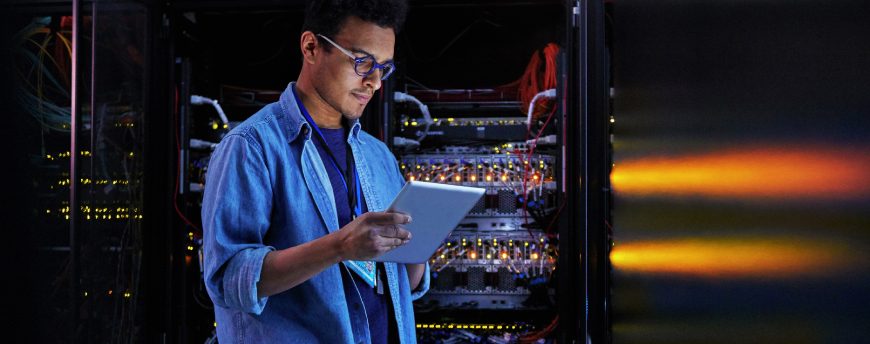Good documentation can be as challenging to develop as the IT infrastructure it’s made for. A typical storage area network (SAN) is a high-speed network of storage arrays and servers connected via host bus adapters and switches.
A SAN diagram is the critical piece of documentation needed to keep track of all those connections.
In this article, we’ll cover five reasons why you should diagram your SAN setup.
- SAN Diagrams Are Worth a Thousand Words
- SAN Diagrams Establish a Single Source of Truth
- SAN Diagrams Help You Comply with Laws and Regulations
- A SAN Diagram Is Important for Your Crash Plan, Recovery, and Support Docs
- SAN Diagrams Help Control TCO
If you don't have a diagram of your SAN and other IT components, now is a great time to make one.
SAN Diagrams Are Worth a Thousand Words
Visually diagramming your SAN is necessary for comprehension. Similar to Ikea’s text-free directions which use images to help you assemble your furniture, SAN diagrams can succinctly communicate the complexities of a SAN to engineers, technicians, and business executives alike.
Most SANs contain the same fundamental technologies. Technicians can make educated guesses regarding the tech stack when triaging SAN issues, but they still need to understand how those essential technologies are pieced together. A SAN diagram creates a visual workflow of how that SAN is created. As a result, it's easier to comprehend, which means technicians can start fixing things faster.
SAN Diagrams Establish a Single Source of Truth
Single source of truth (SSOT) is an information systems and design concept in which data is only mastered once. In other words, while multiple copies of the same document, such as a SAN diagram may exist, there is only one official source from which all others may be copied. This master copy is made available to all relevant parties and supersedes all other sources of information. Expanded to document control, SSOT implies that documents are stored within a single location, ensuring that everyone in an organisation knows where to go to access the latest documentation.
SAN diagrams maintain this single source of truth. Having to hunt for documentation and diagrams costs organisations time and money. For example, suppose that your SAN goes down after upgrading a switch. Technicians will look at the documentation, do a little triage, realize the cables are swapped, and move them to their proper ports.
Without documentation, though, diagnosing and fixing that issue could be a nightmare. What if some of the network ports on that switch aren't used? What if a seasoned network person isn't available to help the technician?
That technician might be stuck trying to tone map network cables to see where those cables go. While that IT tech is tone mapping network cables, they could be fixing other issues. Also, people won’t be able to access the information on that SAN. That means entire departments might be down, and the business could be losing money.
SAN Diagrams Help You Comply with Laws and Regulations
Depending on your industry, it may be a legal requirement to document your network. This is another reason why you should diagram your SAN. In addition, some industries, like the medical or financial industries, must keep a certain level of documentation on hand. This includes IT documentation like SAN diagrams.
Furthermore, the HITECH laws, and other similar regulations, require that organisations prove that they’re taking sufficient steps to keep data safe. Businesses violating those regulations can incur a fine of up to $10,000 per offense. Keep in mind each violation is considered a single customer (or patient for the healthcare industry), so it can get costly.
An easy way to adhere to these regulations is by documenting your IT infrastructure. That includes making a diagram for your SAN. Let's explain further.
First, in the event of an audit, a diagram of your SAN can prove to regulators that you took the steps necessary to secure company data. Infrastructure diagrams can help auditors more easily understand the IT infrastructure you have in place.
Second, creating a diagram for your SAN setup is an excellent way to audit it yourself. The fine details of an enterprise SAN can be lost in deployment. As a result, it's easy to overlook things. Creating a diagram for your SAN setup can help you identify possible issues in your SAN before regulators or customers discover them for you.
A SAN Diagram Is Important for Your Disaster Recovery and Support Docs
From power outages to cyberattacks, today’s IT landscape is fraught with disaster. Sysadmins need to be ready to spring into action at the slightest sign of a cyberattack or network disruption.
When IT admins break out their crash plans and start restoring services, their SAN is one of the first things they need to get running. After all, if the SAN isn't running, they won't have storage for other services to use.
Specific technologies, permissions, or configurations may be used for a variety of different reasons. For instance, an application may require specific settings, or the SAN may have to be configured in a certain way to abide by laws and regulations. A SAN diagram can help IT professionals troubleshoot network disruptions and restore services as fast as possible.
SAN Diagrams Help Control TCO
Total cost of ownership (TCO) is a never-ending concern for organisations. Maintaining and upgrading IT infrastructure can be a labor-intensive endeavor. A SAN diagram gives you a bird’s-eye view of your network’s hardware, connections, and physical locations helping you get strategic about how you implement upgrades and repairs.
For example, instead of buying a new 2U 12-bay SAN appliance for more storage space, techs might realize that they have an existing one already in deployment that is underutilized. Those appliances can be repurposed if needed.
By taking five minutes to look at a SAN diagram, an IT tech could save an organisation thousands of dollars in both materials and time. That's a good ROI.



